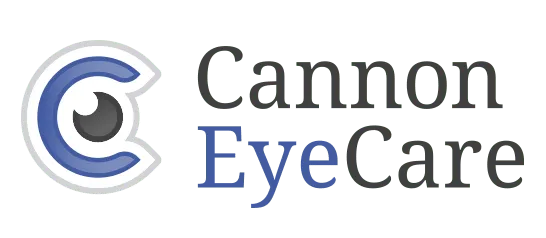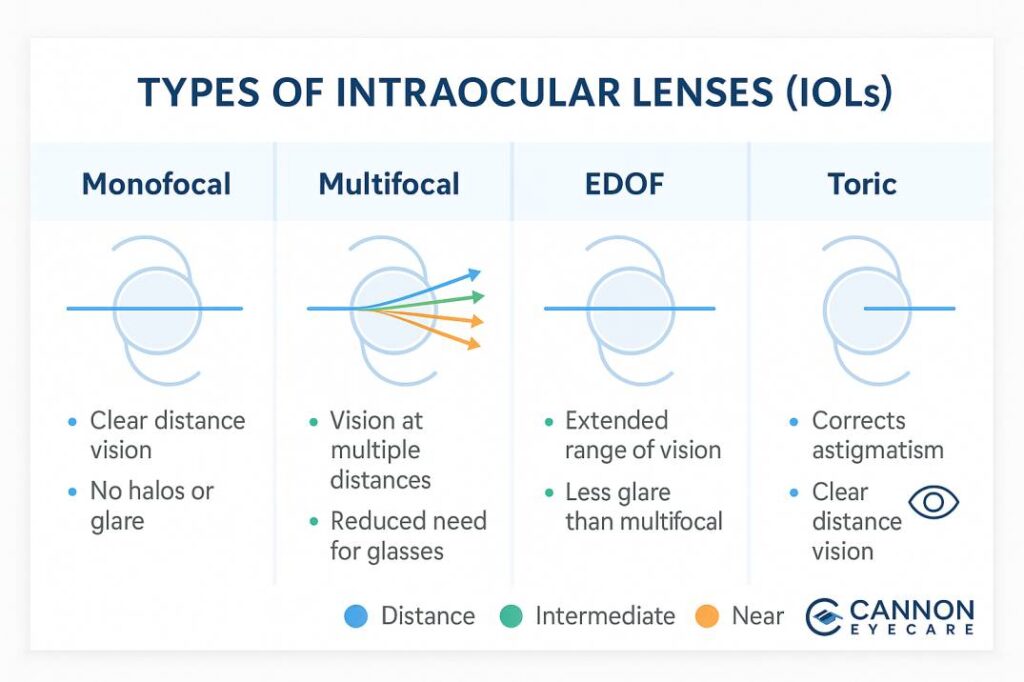Intraocular Lenses
When cataracts cloud your vision, intraocular lenses (IOLs) offer a path back to crystal-clear sight. At Cannon EyeCare, we bring our signature Midwestern hospitality to Seattle’s cataract patients, combining cutting-edge intraocular lens technology with the personalized care you deserve. Whether you’re experiencing your first vision changes or ready for cataract surgery, understanding your intraocular lens options at Cannon EyeCare is crucial for achieving your best possible vision.
What Are Intraocular Lenses? Understanding Your Vision Restoration Options
Intraocular lenses are tiny, artificial lenses surgically implanted in your eye to replace the natural lens that has become clouded by cataracts. Think of them as permanent contact lenses placed inside your eye, designed to restore clear vision without the daily maintenance of glasses or contacts.
During cataract surgery, your surgeon removes the cloudy natural lens and replaces it with an IOL that becomes a permanent part of your eye. Unlike glasses or contact lenses that require ongoing care and replacement, IOLs are designed to last a lifetime, providing consistent vision correction that won’t degrade over time.
Quick Facts About Intraocular Lenses:
- Surgically implanted during cataract surgery
- Permanent vision solution lasting a lifetime
- Multiple technology options available in 2025
- Can correct distance, near, and intermediate vision
- Often reduce or eliminate glasses dependence
The technology behind modern IOLs has advanced dramatically in recent years. Today’s lenses aren’t just simple replacements for your natural lens – they’re sophisticated optical devices that can correct multiple vision problems simultaneously, including nearsightedness, farsightedness, astigmatism, and presbyopia.
Types of Intraocular Lenses: Finding Your Perfect Vision Solution
The four main types of intraocular lenses available in 2025:
- Monofocal IOLs – Clear vision at one distance (usually distance)
- Multifocal IOLs – Multiple focal points for distance, intermediate, and near vision
- Extended Depth of Focus (EDOF) – Continuous range of vision with smooth transitions
- Toric IOLs – Specialized lenses that correct astigmatism
Monofocal IOLs: Clear, Focused Vision at One Distance
Monofocal lenses remain the most commonly chosen IOL option, providing excellent vision at a single focal distance. These lenses offer sharp, high-quality vision with minimal visual side effects like glare or halos. Most patients choose distance focus for driving and daily activities, using reading glasses for close work.
The benefits of monofocal lenses include:
- Exceptional image quality and contrast sensitivity
- Minimal risk of visual side effects
- Often covered by insurance plans
- Predictable visual outcomes
- Lower cost compared to premium lenses
Multifocal IOLs: Freedom from Glasses at Multiple Distances
Multifocal intraocular lenses use advanced optical technology to provide clear vision at multiple distances simultaneously. These sophisticated lenses feature different zones or rings that focus light for near, intermediate, and distance vision, reducing your dependence on glasses for most daily activities.
Recent advances in multifocal IOL technology have significantly improved patient satisfaction. The latest generation of multifocal lenses, including the TECNIS Odyssey IOL which launched in the US in late 2024, offer enhanced light distribution and reduced visual side effects compared to earlier designs.
Extended Depth of Focus (EDOF) IOLs: Smooth Vision Transitions
EDOF lenses represent the newest category of premium IOLs, designed to provide a continuous range of vision from distance through intermediate ranges. These lenses offer a more natural visual experience than traditional multifocal lenses while reducing common side effects like halos and glare.
The advantages of EDOF lenses include:
- Smoother transitions between distances
- Reduced halos and glare, especially at night
- Better contrast sensitivity than multifocal lenses
- Good intermediate vision for computer work
- Natural visual experience
Toric IOLs: Correcting Astigmatism During Cataract Surgery
For patients with astigmatism, toric IOLs offer the opportunity to correct both cataracts and astigmatism in a single procedure. These specialized lenses feature different powers in different meridians of the lens, counteracting the irregular corneal shape that causes astigmatism.
Toric IOLs are available in monofocal, multifocal, and EDOF designs, allowing patients with astigmatism to benefit from any type of vision correction they prefer. Precise measurements and surgical alignment are crucial for optimal results with toric lenses.
Latest IOL Innovations in 2025: Cutting-Edge Technology for Better Vision
The intraocular lenses industry continues to evolve rapidly, with 2025 bringing several breakthrough technologies to benefit cataract patients. At Cannon EyeCare, we stay current with the latest intraocular lenses innovations to offer our patients the most advanced vision solutions available.
Advanced Light Management Technology
Modern IOLs now incorporate sophisticated light management systems that optimize how light enters your eye. In 2025, newer IOL options incorporate technologies that mitigate visual issues like halos and glare. Patients report smoother night vision and a more natural visual experience without compromising on overall quality.
Key Benefits:
- Reduced halos around lights at night
- Improved contrast sensitivity
- Enhanced visual quality in low-light conditions
- Better overall patient satisfaction rates
These improvements are particularly beneficial for patients who drive at night or work in variable lighting conditions.
Dynamic Light Utilization Algorithms
Recent clinical studies have demonstrated the effectiveness of new diffractive IOL designs optimized by dynamic light utilization algorithms. These advanced optical designs provide better light distribution across all viewing distances while minimizing unwanted visual effects.
Adjustable IOL Technology
One of the most exciting developments in IOL technology is the RxSight Light Adjustable Lens (LAL), which received FDA approval and allows fine-tuning of your vision after surgery using light treatments. This technology enables post-surgical adjustments to optimize your visual outcomes, ensuring the best possible results for your lifestyle needs.
How to Choose the Right IOL for Your Lifestyle
Selecting the ideal intraocular lens involves careful consideration of your visual needs, lifestyle requirements, and personal preferences. At Cannon EyeCare, we take time during your consultation to understand your daily activities and vision goals.
Consider Your Daily Activities
Your choice of IOL should align with how you spend your time. Consider these lifestyle factors:
For Active Professionals: If you work primarily on computers or tablets, EDOF lenses may provide the best intermediate vision for screen work while maintaining good distance vision for meetings and presentations.
For Outdoor Enthusiasts: Monofocal distance lenses often provide the sharpest vision for sports and outdoor activities, with reading glasses used as needed for close tasks.
For Readers and Crafters: Multifocal lenses can provide excellent near vision for hobbies while maintaining functional distance vision, though some patients prefer monofocal near lenses for maximum reading comfort.
Evaluate Your Visual Priorities
Consider which distances are most important to you:
- Distance Vision: Essential for driving, sports, and recognizing faces across a room
- Intermediate Vision: Critical for computer work, cooking, and dashboard viewing
- Near Vision: Important for reading, smartphone use, and detailed close work
Assess Your Tolerance for Visual Trade-offs
Premium IOLs offer reduced dependence on glasses but may involve some visual compromises:
- Glare and Halos: Some multifocal lenses can cause rings around lights, especially at night
- Contrast Sensitivity: Premium lenses may slightly reduce contrast compared to monofocal lenses
- Adaptation Period: Your brain needs time to adapt to multifocal or EDOF lenses
The IOL Selection Process at Cannon EyeCare
Our comprehensive approach to intraocular lenses selection at Cannon EyeCare ensures you receive the lens that best matches your needs and expectations. We combine advanced diagnostic technology with personalized consultation to guide your intraocular lenses decision.
Detailed Pre-Surgical Evaluation
Your IOL selection begins with thorough eye measurements and health assessment:
Biometry and Corneal Analysis: We use advanced diagnostic equipment to measure your eye’s dimensions and corneal characteristics, ensuring precise IOL power calculations.
Lifestyle Assessment: Our team discusses your daily activities, visual demands, and personal preferences to understand your ideal vision outcomes.
Health Screening: We evaluate your overall eye health and any conditions that might influence IOL selection, such as macular degeneration or glaucoma.
Personalized Consultation and Education
During your intraocular lenses consultation at Cannon EyeCare, we explain each IOL option in detail, using visual aids and patient examples to help you understand the differences. We believe in informed decision-making and encourage questions throughout the intraocular lenses selection process.
Our experienced team takes time to address your concerns and expectations, ensuring you feel confident about your IOL choice. We provide realistic expectations about visual outcomes and discuss any potential limitations or side effects.
Advanced Surgical Planning
Once you’ve selected your IOL, we use precise measurement and planning tools to optimize your surgical outcome. This includes:
- Detailed IOL power calculations using multiple formulas
- Surgical alignment planning for toric lenses
- Discussion of surgical techniques to minimize complications
What to Expect: The IOL Implantation Process
Understanding the surgical process helps reduce anxiety and ensures optimal outcomes. At Cannon EyeCare, we prioritize patient comfort and safety throughout your cataract surgery experience.
Pre-Surgical Preparation
Before your surgery, we provide detailed instructions for preparation, including:
- Medication adjustments as needed
- Eye drop regimens to prevent infection
- Dietary and activity guidelines
- Transportation arrangements
The Surgery Day Experience
Cataract surgery with IOL implantation is typically completed in 15-20 minutes and performed on an outpatient basis. The procedure involves:
- Anesthesia: Local anesthesia ensures comfort without general sedation
- Lens Removal: Advanced techniques remove the cloudy natural lens
- IOL Insertion: Your selected IOL is carefully positioned in the eye
- Wound Closure: The tiny incision typically heals without stitches
Post-Surgical Recovery and Healing
Recovery from IOL implantation is generally quick and comfortable:
Immediate Recovery: Most patients notice improved vision within hours of surgery, though full healing takes several weeks.
Follow-up Care: We monitor your healing progress with scheduled appointments to ensure optimal outcomes and address any concerns.
Activity Restrictions: Temporary limitations on heavy lifting and water exposure protect your healing eye.
Maximizing Your IOL Investment: Long-term Care and Maintenance
While IOLs require no daily maintenance like glasses or contacts, proper eye care ensures lasting visual benefits and eye health.
Protecting Your Investment
Your IOL represents a significant investment in your vision and quality of life. Protect this investment through:
Regular Eye Exams: Annual comprehensive eye exams monitor IOL position and overall eye health, detecting any issues early.
UV Protection: Quality sunglasses protect your eyes and IOL from harmful ultraviolet radiation that can affect surrounding eye tissues.
Healthy Lifestyle: Good nutrition, regular exercise, and not smoking support overall eye health and may prevent other vision problems.
Addressing Potential Complications
While IOL complications are rare, awareness helps ensure prompt treatment if issues arise:
Posterior Capsule Opacification: Sometimes called “secondary cataracts,” this clouding behind the IOL can be easily treated with laser therapy.
IOL Dislocation: Rarely, an IOL may shift position, which can usually be corrected with additional surgery.
Infection: Though extremely rare, any signs of infection require immediate medical attention.
Scientific Evidence Supporting IOL Benefits
Recent clinical research continues to demonstrate the safety and effectiveness of modern IOL technology. Three significant studies support the benefits of contemporary intraocular lenses:
A 2024 study published in the journal Eye evaluated clinical outcomes with new diffractive multifocal IOLs optimized by dynamic light utilization algorithms. This observational, prospective, longitudinal study included 64 eyes underwent bilateral cataract surgery with the Intensity IOL (Hanita Israel) implantation. The research demonstrated improved visual outcomes across all distances with reduced side effects compared to earlier multifocal designs.
Clinical trials of the latest IOL technologies show promising results for patient satisfaction and visual quality. Compared to TECNIS Synergy™ and TECNIS™ Multifocal IOLs based on pre-clinical bench testing, newer designs offer enhanced optical performance and reduced visual disturbances.
Long-term follow-up studies continue to confirm the durability and stability of IOL implants. Unlike contact lenses or glasses, they don’t require replacement or adjustment. Most people will never need to think about their IOL again after surgery, apart from routine eye checks. This permanence makes IOLs an excellent long-term investment in vision health.
Cost Considerations and Insurance Coverage for IOLs
Understanding the financial aspects of IOL selection helps you make informed decisions about your vision investment. At Cannon EyeCare, we provide transparent pricing and work with your insurance to maximize benefits.
Insurance Coverage for Standard IOLs
Most insurance plans, including Medicare, cover the cost of cataract surgery with standard monofocal IOLs. Medicare covers standard cataract surgeries that involve the implantation of basic monofocal IOLs, as they are considered medically necessary. This coverage typically includes:
- Pre-surgical evaluations and measurements
- The surgical procedure itself
- Standard monofocal IOL implantation
- Post-operative care and follow-up visits
Premium IOL Upgrade Options
Advanced IOLs like multifocal, EDOF, and toric lenses are considered premium upgrades. While insurance covers the basic cataract surgery portion, patients typically pay an additional $2,000 to $4,000 per eye for premium lens features. This investment often pays for itself through reduced dependence on glasses and improved quality of life.
Financing Options and Payment Plans
We offer various payment options to make premium IOLs accessible:
- Flexible payment plans
- Healthcare financing through approved providers
- HSA and FSA account acceptance
- Transparent pricing with no hidden fees
Why Choose Cannon EyeCare for Your Intraocular Lenses Journey
At Cannon EyeCare, we combine the latest intraocular lenses technology with our signature approach to patient care. Our commitment to thorough evaluation, personalized consultation, and ongoing support ensures you receive the best possible vision outcomes with your intraocular lenses at Cannon EyeCare.
Our Unique Advantages
Comprehensive Evaluation: We use advanced diagnostic technology to precisely measure your eyes and assess your candidacy for different IOL types, ensuring optimal outcomes.
Personalized Consultation: Our unhurried approach allows time to discuss your lifestyle, visual needs, and expectations, helping you make an informed IOL selection.
Advanced Technology: We stay current with the latest IOL innovations, offering our patients access to cutting-edge lens technologies as they become available.
Ongoing Support: Our relationship doesn’t end with surgery. We provide comprehensive post-operative care and long-term eye health monitoring to protect your vision investment.
Convenient Seattle Locations
With locations in University Village and Pike Place Market, we make it easy for Seattle-area patients to access expert IOL consultation and care.
University Village Location:
- Free parking available
- Modern, comfortable facilities
- State-of-the-art diagnostic equipment
- Easy access from I-5 and SR-520
Pike Place Market Location:
- Public transportation accessible
- Downtown convenience
- Historic Seattle landmark setting
- Walking distance from major hotels
Both locations feature the same high-quality care and advanced technology that define the Cannon EyeCare experience.
Schedule Your Intraocular Lenses Consultation at Cannon EyeCare
If you’re experiencing vision changes that might indicate cataracts, or if you’ve been told you need cataract surgery, scheduling an intraocular lenses consultation at Cannon EyeCare is your first step toward clearer vision. Our comprehensive evaluation will determine your intraocular lenses candidacy and help you understand your options.
What to Expect During Your Consultation:
- Detailed eye measurements and health assessment
- Discussion of your lifestyle and visual priorities
- Explanation of IOL options that match your needs
- Realistic expectations about outcomes
- Answers to all your questions about the process
Ready to explore your intraocular lens options?
- Call Cannon EyeCare: (206) 555-0123
- Book Online: Schedule Your IOL Consultation
- Visit Us: University Village or Pike Place Market locations
Don’t let cataracts limit your vision and lifestyle. With the right intraocular lenses and expert care from Cannon EyeCare, you can return to the activities you love with clear, comfortable vision. Contact Cannon EyeCare today to schedule your comprehensive consultation for intraocular lenses and take the first step toward achieving your best possible vision.
FAQs
-
Intraocular lenses (IOLs) are artificial replacement lenses implanted during cataract surgery to restore clear vision after your natural lens becomes cloudy




